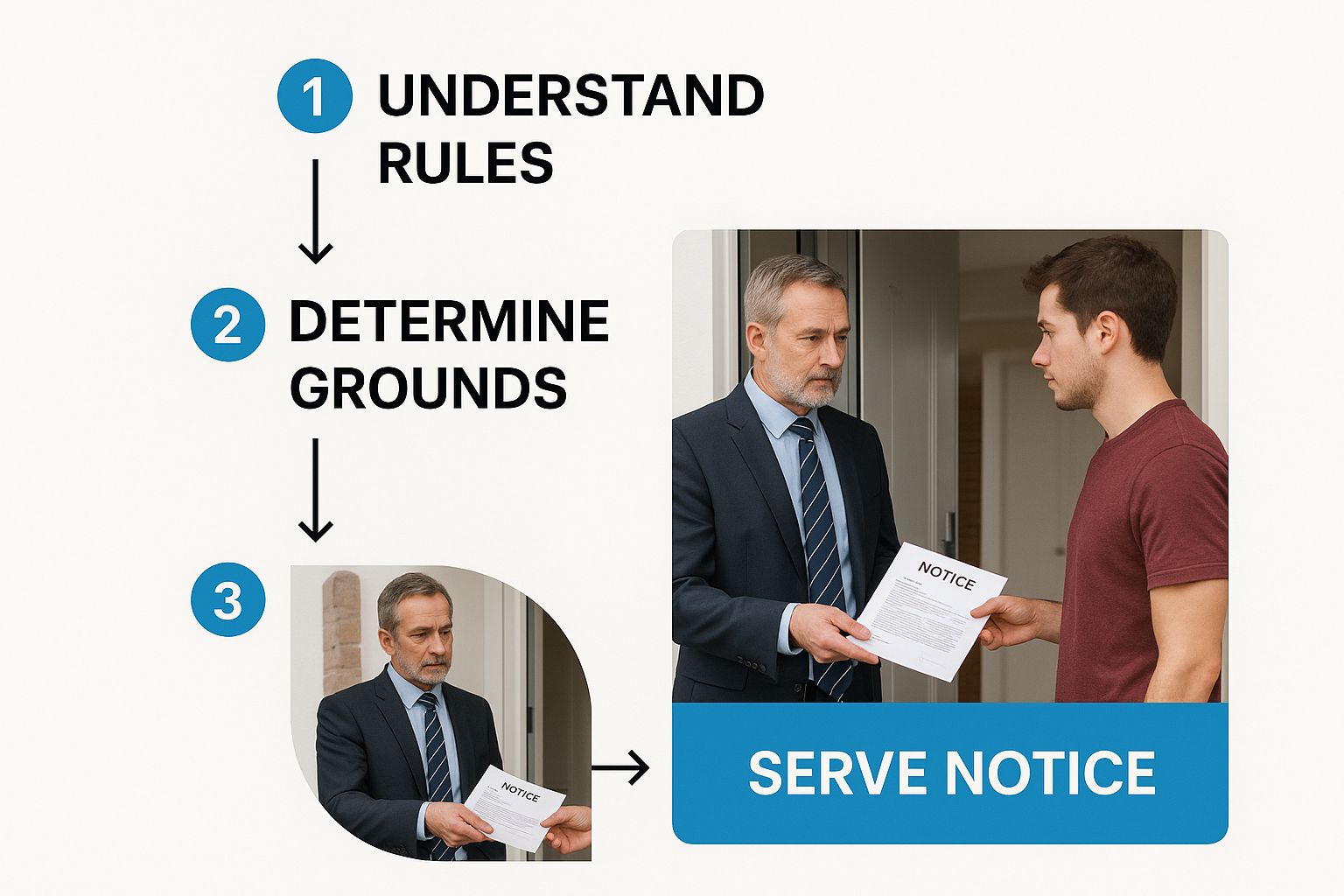When you're managing a portfolio of hundreds or thousands of rental units, a non-paying or disruptive tenant isn't just a headache—it's a direct threat to your operational efficiency and revenue per door. Every day that unit remains occupied by a problem tenant is a day of lost revenue that directly impacts your portfolio's financial performance. But before you initiate an eviction, your operational playbook must ensure the process is legally airtight.
One wrong move, one procedural slip-up, and you could find yourself back at square one, facing extended vacancy, compounding revenue loss, and a detrimental impact on your Days on Market (DOM) metric.
Establishing Lawful Grounds for an Eviction
You can't evict a tenant based on a gut feeling or a minor disagreement. For large-scale operators, the entire process must be systemized and hinge on a documented material breach of the lease agreement—a violation so significant that it breaks the very foundation of the contract. Attempting to remove a tenant for a trivial issue is a surefire way to waste time, money, and have a judge dismiss your case, further damaging your cost-per-door metrics.
Think of it as building an airtight legal case. Your first step is to ensure you have an undeniable, legally sound reason to proceed, documented and verified through a standardized internal process.
Common Reasons to Start the Eviction Process
While the fine print varies by state and even city, the core reasons you can legally start an eviction are fairly consistent. Your team's operational playbook should be crystal clear on what qualifies to ensure consistency across your entire portfolio.
Here are the usual triggers:
- Non-Payment of Rent: This is the most common trigger, directly impacting your cash flow. The moment a tenant blows past their due date and any grace period outlined in the lease, you have a valid reason to act.
- Significant Lease Violations: We're not talking about a messy room. This covers major issues like acquiring a pet against a no-pet policy, causing substantial property damage, or having unauthorized people living in the unit long-term. The violation must be material and well-documented.
- Illegal Activity: If a tenant is involved in criminal acts on the property—think drug-related offenses or other serious crimes—you can often move forward with an expedited eviction process.
- Holding Over After a Lease Ends: When a lease term expires and the tenant refuses to vacate, you can file for eviction to legally regain possession of your property and begin the turn process to minimize vacancy loss.
Don't Skip the Pre-Eviction Audit
Before a single notice is generated, your operations team must perform a meticulous pre-eviction audit. This isn't optional; it's a critical internal control to ensure your case is defensible. Skipping this step can lead to administrative errors that get your case dismissed, forcing you to restart the entire process and extending your Days on Market.
A flawed eviction can add weeks, or even months, to your vacancy period. For a 1,000-unit portfolio, just 20 evictions with an extra 30 vacancy days could cost your portfolio over $40,000 in lost rent (assuming an average rent of $2,000/month).
A standardized checklist, ideally integrated into your property management system, is your best defense against procedural errors.
To help your team quickly assess the situation, here’s a quick-reference guide to the most common grounds for eviction and the typical first action you'll take.
Quick Reference Legal Grounds for Eviction
This audit is all about the details. Your team will need to pull together the signed lease agreement, a full and accurate payment ledger, and any documented communication with the tenant about the issue.
And don't forget your move-in and move-out condition reports. This documentation is your proof when demonstrating damages. As any seasoned portfolio manager knows, understanding the importance of condition reports is crucial for protecting the owner's asset and justifying any deductions or legal action. A well-organized, thoroughly documented file shows you mean business and positions your team to move forward efficiently and with confidence.
Drafting and Serving the Official Eviction Notice
Alright, you’ve confirmed you have solid legal ground to move forward. Now comes the most critical paperwork of the entire process: the official eviction notice.
This isn’t just a letter. It's a legal instrument, and one slip-up—a wrong date, an incorrect rent figure, or serving it improperly—can get your case tossed out of court. When that happens, you’re back to square one. For a property manager handling a large portfolio, these preventable delays are a direct hit to the bottom line, bloating your Days on Market (DOM) and compounding vacancy losses.
The goal of the notice is simple: clearly tell the tenant what they did wrong and give them a legally required chance to either fix it or move out. Precision is everything.
Choosing the Right Type of Eviction Notice
Not all lease violations are the same, so you can't use a one-size-fits-all notice. This is a common and costly mistake. Your operational playbook needs to be crystal clear on which notice to use for which scenario to maintain compliance and consistency at scale.
- Pay Rent or Quit Notice: This is your workhorse, used for the most common issue—non-payment of rent. It gives the tenant a short window (usually 3-5 days, depending on your state) to pay what's owed in full or vacate the property.
- Cure or Quit Notice: This one is for fixable problems. Think an unauthorized pet, an unapproved roommate, or minor property damage. The notice gives them a set amount of time to "cure" the violation, like rehoming the pet or making repairs. If they don't, you can proceed with the eviction.
- Unconditional Quit Notice: This is reserved for serious violations that can't be corrected. We're talking illegal activity on the property, severe damage, or a pattern of repeated violations after you've already sent warnings. This notice tells them to leave, period. No second chances.
The infographic below shows that first, crucial interaction—serving the notice.

This is the moment where everything has to be done by the book, kicking off a process that affects both the tenant and your property's financial performance.
The Anatomy of a Bulletproof Notice
For a notice to hold up in court, it absolutely must contain specific information. Miss one detail, and the whole thing could be invalid. A standardized, lawyer-approved template integrated into your property management software is a must-have for any property manager operating at scale.
Make sure every notice includes:
- Tenant and Property Details: The full names of every adult on the lease and the complete property address.
- The Specific Reason: State the violation clearly (e.g., "Failure to pay rent for the month of August 2025"). No vague language.
- The Exact Amount Owed (If Applicable): For a Pay Rent or Quit notice, you need the precise amount due. Don't estimate.
- A Clear Deadline: State the exact date by which the tenant must pay, fix the issue, or move out.
- An Unambiguous Statement: Add a sentence that makes it clear you will start legal eviction proceedings if they fail to comply by the deadline.
Serving the Notice The Right Way
How you deliver the notice is just as important as what’s in it. Every state has strict rules for "service of process," and if you don't follow them to the letter, your case is dead on arrival.
Proper service is non-negotiable. The court will demand proof that the tenant actually received the notice. Without that proof, you have no case.
The most common methods are:
- Personal Service: Handing the notice directly to the tenant. This is always the best-case scenario.
- Substituted Service: Leaving the notice with another responsible adult at the property, then mailing a second copy.
- Posting and Mailing: Taping the notice to the front door and mailing a copy (certified mail is recommended for a paper trail). This is usually your last resort if you can’t make personal contact.
For multi-market portfolios or hard-to-reach tenants, think about hiring a professional process server. It standardizes the process and can save you a massive headache down the road.
No matter how you serve it, immediately fill out a "Proof of Service" or "Affidavit of Service" form. This is your sworn statement documenting when, where, and how you delivered the notice. It’s a vital piece of evidence you’ll need for court.
Filing the Lawsuit and Navigating the Court System
So, you've sent a legally solid eviction notice, the deadline has passed, and the tenant is still there. Now what? This is a critical junction. Every day you delay translates directly into increased vacancy costs and a higher Days on Market (DOM) for that unit. For managers of large, distributed portfolios, this isn't a time for hesitation—it's time to execute a well-defined legal strategy.
A tenant who ignores a formal notice is unlikely to leave voluntarily. Initiating the lawsuit is the only way to regain control of your asset and start the clock on getting it rent-ready again.
From Notice to Lawsuit: What to File
The official legal action to remove a tenant is most commonly called an Unlawful Detainer. You might see it called something else depending on your state, but the goal is the same: asking the court to legally order the tenant out.
To get the ball rolling, you'll be preparing and filing two core documents with the local court:
- The Complaint: This is your side of the story, put into a formal legal document. It lays out who you are (the plaintiff), who the tenant is (the defendant), and the specific, legally sound reason you're evicting them. You’ll reference the lease and the notice you already served.
- The Summons: Think of this as the official "you've been sued" notice for the tenant. It tells them a lawsuit has been filed against them and gives them a very short window—often just five days—to file a formal response with the court.
I can't stress this enough: you need 100% accuracy here. A simple typo in the tenant's name, a digit off in the address, or an error in describing the lease violation can get your case thrown out. For a large portfolio, a dismissal on a technicality means you’re back to square one—a costly and completely avoidable delay that hits your revenue stream hard.
Serving the Lawsuit: The Legal Hand-Off
Just like the initial notice, you can't just mail or email the Summons and Complaint. The court requires a formal "service of process" to make sure the tenant officially receives the documents.
This is a job for a registered process server or the local sheriff's department. Yes, there's a fee, but it's a non-negotiable part of staying compliant. Never have one of your own employees serve the papers; it creates a conflict of interest and opens the door to legal challenges. Once served, the server provides you with a Proof of Service, which you then file with the court.
Expert Tip: Once the lawsuit is filed, all direct communication with the tenant should cease. Period. Let your legal counsel handle everything from here on out. Direct communication can muddy the waters and even jeopardize your legal position.
After being served, it’s the tenant's move. They have a limited time to file an "Answer" with the court, which is their formal defense. Many tenants never respond. When that happens, you usually win by default. If they do file an Answer, a court date is set, and you prepare for a hearing.
Navigating the Court Timeline
The timeline from filing to getting a court date can be all over the map. An uncontested case where the tenant doesn't respond might be wrapped up in a few weeks. But a contested case? That can drag on for months, which is why flawless execution in the early stages is so critical to your bottom line.
The scale of this process is massive. Recent data shows landlords filed over one million eviction cases in tracked U.S. jurisdictions alone. Nine cities saw filing rates hit 10% or more—that's at least one case for every ten renter households. Phoenix even hit a record-breaking 86,946 filings, averaging one every six minutes. You can explore more on these eviction trends to get a sense of the national landscape.
For a large portfolio, you can't manage this process on spreadsheets and sticky notes. You need a system. Use your property management software or a legal tracker to stay on top of key dates for every single case:
- Date the Summons and Complaint was filed.
- The deadline for the tenant's Answer.
- The scheduled court hearing date.
Missing a deadline or showing up to court unprepared is simply not an option. A centralized system ensures your team or attorney is always ready for the next move, turning a chaotic process into a predictable, manageable operation that minimizes revenue loss.
How to Prepare for and Win Your Court Hearing
The eviction lawsuit is filed, and a court date is on the calendar. This is where your operational rigor—or lack thereof—directly impacts your bottom line. Winning in court isn't about drama; it's about meticulous, systematic organization.
A lost case is a massive setback. It doesn't just mean the tenant stays; it means you're back at square one, looking at another 30-60 days of lost rent and mounting legal fees. A professional, well-organized presentation is often the deciding factor between regaining possession and facing a costly dismissal.

Assembling Your Bulletproof Evidence Package
Walking into that courtroom without a perfectly organized evidence binder is an amateur mistake that can sink your case before you even start. Your job is to hand the judge a clear, undeniable story of the lease violation, backed by cold, hard facts. Think of it as building an open-and-shut case that respects the court's time.
This isn’t the time for shuffling through a messy folder. Your evidence needs to be comprehensive, professional, and easy for the judge to follow.
- The Signed Lease Agreement: This is your foundation. Have it tabbed and ready to go.
- The Payment Ledger: For non-payment cases, a clean, system-generated ledger is non-negotiable. Highlight the missed payments so the judge can see the delinquency at a glance.
- The Eviction Notice & Proof of Service: Bring a copy of the exact notice you served, along with the signed affidavit proving it was delivered correctly. This shows you followed legal procedure to the letter.
- Photo and Video Evidence: If the eviction is over property damage, this is your most powerful tool. Make sure every photo and video is date-stamped and clearly labeled.
- Communication Logs: This is where great property management technology shines. A full record of every email, text, and call note from your CRM demonstrates your attempts to resolve the issue fairly. Solid record-keeping is the cornerstone of a strong manager-tenant relationship, and you can learn more about effective communication tips to strengthen that dynamic in our other guide.
Putting together a solid evidence package is crucial. To make it even easier, we've created a simple checklist to ensure you never miss a critical document.
Eviction Hearing Preparation Checklist
Use this table as your guide to assemble a complete and persuasive evidence package for every hearing. Having everything organized and ready demonstrates your operational professionalism to the court.
Having these documents organized into a binder—with copies for yourself, the judge, and the tenant—will set you up for a much smoother, more efficient hearing.
Presenting Your Case with Professionalism
On court day, how you act matters just as much as what you bring. Dress professionally. Arrive early. And always have at least three copies of your evidence binder: one for you, one for the judge, and one for the tenant or their attorney.
When it's your turn, be direct. Stick to the facts. State the reason for the eviction, walk the judge through your evidence logically, and answer any questions without getting defensive. Avoid emotional language or making it personal.
Your goal is not to win an argument with the tenant. It's to prove to the judge that you have met the legal standard for an eviction. A calm, fact-based presentation is always more powerful.
Anticipating Common Tenant Defenses
Tenants often raise defenses to get a case dismissed, whether they’re valid or not. Being ready for these is half the battle. You’ll frequently hear claims of improper notice, retaliation for a maintenance request, or that you refused to accept their rent payment.
This is where your meticulous documentation becomes your best weapon. If a tenant claims you retaliated, your maintenance logs showing a history of prompt repairs will shut that down. If they claim you refused rent, your communication log and clear policy on not accepting partial payments will back you up.
By thinking ahead and having the evidence to counter these common arguments, you put yourself in the best possible position for a quick, successful outcome that minimizes your vacancy loss.
Regaining Possession and Managing Post-Eviction Logistics
You’ve won the court case. It feels like the end, but it’s really just the beginning of the final, most critical phase: asset recovery. That judgment for possession is a major hurdle cleared, but it doesn't magically hand you the keys.
This is where the rubber meets the road. Every single day the property sits occupied post-judgment, your Days on Market (DOM) ticks up, and your revenue per door takes a direct hit. For property managers operating at scale, a lightning-fast, standardized process for this "last mile" isn't a luxury—it's essential for portfolio health.
The focus shifts from winning a legal battle to executing a swift, legal, and efficient asset recovery. It’s all about getting the property back so the turn process can finally begin. This stage demands precision and strict adherence to the law to sidestep any costly last-minute mistakes.
First, Get the Writ of Possession
The judge’s ruling is just words until you get the Writ of Possession (you might also hear it called a Writ of Eviction or Restitution). This is the official court order that empowers law enforcement to physically remove the tenant. It’s not an optional piece of paper; it’s the legal tool you need to proceed.
Don't expect to walk out of the courtroom and head straight to the sheriff. There’s usually a brief waiting period after the judgment before you can even request the writ. Once it’s issued, you’ll deliver it to the county sheriff or marshal’s office to get on their schedule for the physical lockout. Expect to pay a fee and be patient—these departments are almost always backed up.
Coordinating the Lockout with Law Enforcement
The lockout is a scheduled appointment where you or your representative meet a law enforcement officer at the property. Their job is simply to keep the peace while your locksmith changes the locks, officially and legally barring the tenant from returning.
You need to show up prepared and professional.
- Have a Locksmith on Standby: Don’t wait until the day of to find a locksmith. Have one scheduled and ready to go for the exact time. Any fumbling here causes delays you simply can’t afford.
- Be on Time. Period. The sheriff won't wait for you. If you miss your scheduled slot, you could be pushed to the back of the line, potentially adding weeks to your vacancy.
- Document Everything. The second the locks are changed, pull out your phone. Take photos and video of the property’s condition to create a clear, timestamped record of how it looked the moment you regained possession for your records.
The finality of a lockout can be a tough, emotionally charged moment. It's a stark reminder of the housing instability many people grapple with. In fact, economic pressures have put a significant portion of the population at risk. One analysis highlighted that by the end of 2020, nearly 29% of American renters were at risk of eviction.
Handling Abandoned Personal Property
Here’s one of the biggest post-eviction legal landmines: mishandling a tenant's belongings. You absolutely cannot just toss everything into a dumpster. States have very specific, and often strict, laws governing how you must deal with abandoned personal property.
While the specifics vary, the general process looks like this:
- Inventory Every Single Item: Make a detailed, written list of everything the tenant left behind. Back it up with photos.
- Store the Property Securely: You are legally required to store the items in a safe place.
- Send a Formal Notice: You must send a written notice to the tenant's last known address. This notice needs to list the property, say where it's being stored, and give them a clear deadline to come and claim it.
Skipping these steps can land you in court again, facing a lawsuit from the former tenant for the value of their property. A standardized, checklist-driven procedure for your team is the only way to mitigate this risk across your portfolio.
Once the unit is legally yours and completely empty, it’s go-time for the turn. A fast, meticulous make-ready process is what separates the pros. A sparkling clean unit not only attracts high-quality tenants faster but can also head off security deposit disputes. To make this foolproof, an ultimate end of tenancy cleaning checklist is an invaluable tool for your team.
At the end of the day, turning a necessary eviction into an efficient turnover is a core competency for any serious property manager. To learn more about turning these operational wins into financial gains, check out our guide on 8 ways to boost your property's ROI.
Common Questions We Hear About the Eviction Process
Even when you have a rock-solid eviction process, you're going to get curveballs. For those of us managing large distributed portfolios, having clear, legally sound answers ready is non-negotiable. One wrong move can derail an eviction, balloon your vacancy days, and hit the portfolio's revenue hard.
Let's dive into some of the most common questions that pop up, with direct answers to help your team handle these tricky situations like pros.

Can I Just Change the Locks or Shut Off the Power to Get Them Out?
Absolutely not. This is probably the single most dangerous and expensive mistake a property manager can make. These are called "self-help" evictions, and they are illegal in every single state.
Taking matters into your own hands—whether it's changing the locks, tossing their belongings on the curb, or cutting the utilities—is a fast track to a lawsuit. The penalties can be severe, and it will instantly kill any legitimate eviction case you had in progress.
The only legal way to remove a tenant is with a court order (often called a Writ of Possession) executed by a law enforcement officer. Anything else is an illegal lockout, and it will backfire spectacularly.
What If a Tenant Pays Part of the Rent After I've Sent an Eviction Notice?
This is a huge red flag for your operations. Accepting a partial payment after you've served a "Pay Rent or Quit" notice is one of the easiest ways to torpedo your own case. In most courts, taking any money is seen as waiving your right to evict for that specific issue.
Suddenly, you’re back at square one. You have to start the entire process over, adding weeks or even months of lost rent to your books. This is why a strict, portfolio-wide policy of no partial payments after a notice is served is a non-negotiable best practice.
If there's an incredibly rare situation where you must consider it, consult your legal counsel first. Then, you absolutely must get the tenant to sign a "non-waiver agreement." This is a formal document stating that by accepting their money, you are not canceling the eviction. Without that signature, you’re taking an enormous risk.
So, How Long Does an Eviction Actually Take?
This is the million-dollar question for forecasting vacancy loss, but the truth is, it depends. The timeline can swing wildly based on a few key factors:
- Your Location: Court backlogs and local laws can turn a four-week process into a four-month ordeal. A backed-up court in a major city will move much slower than one in a rural county.
- The Tenant's Response: This is the biggest variable. Do they contest it or not?
An uncontested eviction is the best-case scenario. This is where the tenant doesn't respond or show up to court. From the initial notice to the sheriff locking the door, you might be looking at as little as 3-4 weeks.
But a contested eviction—where the tenant files an answer and shows up to fight—can drag on for months. For large-scale property managers, simple procedural mistakes are what cause most of these delays. A standardized, flawless process isn't just about following the rules; it's a core strategy for keeping vacancy days down and protecting revenue.
What Are the Most Expensive Mistakes to Avoid?
Beyond major legal blunders, a few common operational errors can cost you a fortune. Systematizing your process to sidestep these is crucial for maintaining cost-per-door efficiency.
The costliest mistakes we see are:
- Improperly Serving Notices: This is the #1 reason evictions get thrown out. If you don't deliver the notice or lawsuit paperwork exactly as the law requires, your case is dead on arrival.
- Taking Partial Rent: As we covered, this simple mistake can undo all your work unless you have that non-waiver agreement signed.
- Sloppy Paperwork: Messy rent ledgers, no records of communication, or a lack of photos documenting damages will severely weaken your case if you end up in front of a judge.
- Retaliatory Actions: Trying to evict a tenant right after they submit a valid maintenance request or call code enforcement looks like illegal retaliation.
- Mishandling Abandoned Property: Once the tenant is out, there are strict rules for handling anything they left behind. Tossing their belongings can lead to a whole new lawsuit.
Avoiding these pitfalls is the key to a fast, compliant eviction that gets your property rent-ready again without unnecessary drama or expense.
Managing the entire leasing cycle—from the first lead to a signed lease—is a complex job, especially at scale. An eviction forces you to restart that cycle immediately to protect revenue. Showdigs offers an AI-powered leasing automation platform that slashes Days on Market by automating showings, qualifying leads, and filling your vacancies faster than ever.
Learn how Showdigs can accelerate your leasing velocity and boost your portfolio's ROI.







